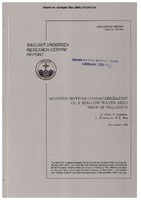Acoustic bottom characterization of a shallow water area west of Mallorca

Abstract
An experiment was conducted in shallow water on the Balearic Shelf west of the island of Mallorca. The seafloor in this area consists of a patchy layer of sediment less than 4 m thick overlying a hard limestone bottom. The compressional and shear velocities of the bottom were measured by remote sensing techniques using a geophone/hydrophone array deployed on the bottom and explosive sources. The compressional velocity in the basement was found to increase from 1970 mls at the sediment-basement interfax to 4305 m/s at a depth of 174 m. The shear velocity, detamined from the inversion of interfax wave data, was ambiguous, since there were two arrivals which could be interpreted as the interface wave. The slower arrival gave a shear velocity of about 600 m/s while the faster arrival gave a shear velocity of about 1 100 m/s. Two geoacoustic models were constructed based on these results and used as inputs to SAFARI to predict transmission loss. Simultaneously with the bottom measurements, transmission loss was measured in a 100-1600 Hz band using explosive sources and a four element vextical array. At high firequencies (400, 800, 1600 Hz),in most cases, transmission loss predictions from both geoacoustic models annpmd reasonably well with the easurements, but at low frequencies(100,200 Hz) the higher shear velocity model gave better agreement. The optimum frequency of propagation was about 800 Hz, higher than normally found in shallow water. This result is in agreement with theoretical predictions and is due to conversion to and subsequent absorption of shear waves in the bottom. It is suggested that the ambiguity in the determination of shear velocity could be due to anisotropy in the bottom.
Report Number
SR-243Date
1995/12Author(s)
Caiti, Andrea
; Ingenito, Frank
; Kristensen, Age
; Max, Michael D.